上一篇分享了安装、迁移,本篇将继续分享迁移前操作、 DRS迁移数据、迁移后一致性检查、问题总结及解决方法。
目录
四、迁移前操作
4.1 源端(PG)
确定迁移的对象
统计源数据库对象
1、统计数据库个数
psql –d postgres -p 15432\l+ --统计数据库名称以及大小
\du –统计数据库所有用户
\c 数据库名称 --
\dn 统计数据中schema的名称
3.1.1.2 创建迁移用户及赋权
创建只读用户用于读取数据库全部对象,该用户用于DRS工具迁移数据
Create user drs_read password ‘Drs_read#2023’;
grant usage on schema power_tf,power_reliability,power_work,power_ds,power_tech,power_quality,power_sch,power_common to drs_read;
grant usage on schema power_tf,power_reliability,power_work,power_ds,power_tech,power_quality,power_sch,power_common to drs_read;
grant select on all sequence in schema power_common,power_tf,power_reliability,power_work,power_ds,power_tech,power_quality,power_sch to drs_read;
grant select on all sequences in schema power_work,power_ds,power_tech,power_quality,power_sch to drs_read;
grant select on all tables in schema power_work,power_ds,power_tech,power_quality,power_sch to drs_read;4.2 目标端(GaussDB库)
创建复制用户及赋权
gsql –d postgres –p 15432
gauss=#create user drs_rep password ‘Drs_rep#2023’;
gauss=#alter user drs_rep sysadmin;UGO迁移表结构
使用UGO工具,可以迁移数据库结构、表结构、索引、函数等元数据。
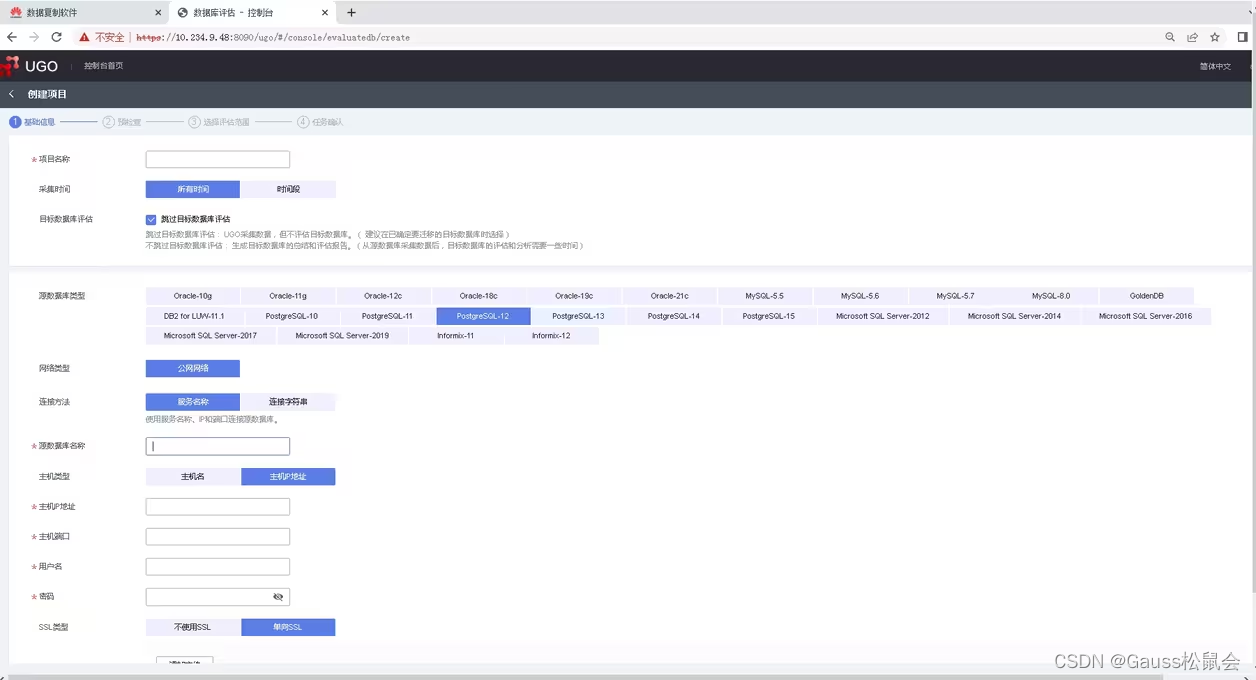
1、创建项目,进行源端数据库评估。

迁移结构后会提示迁移成功和失败的对象百分比,如图所示:
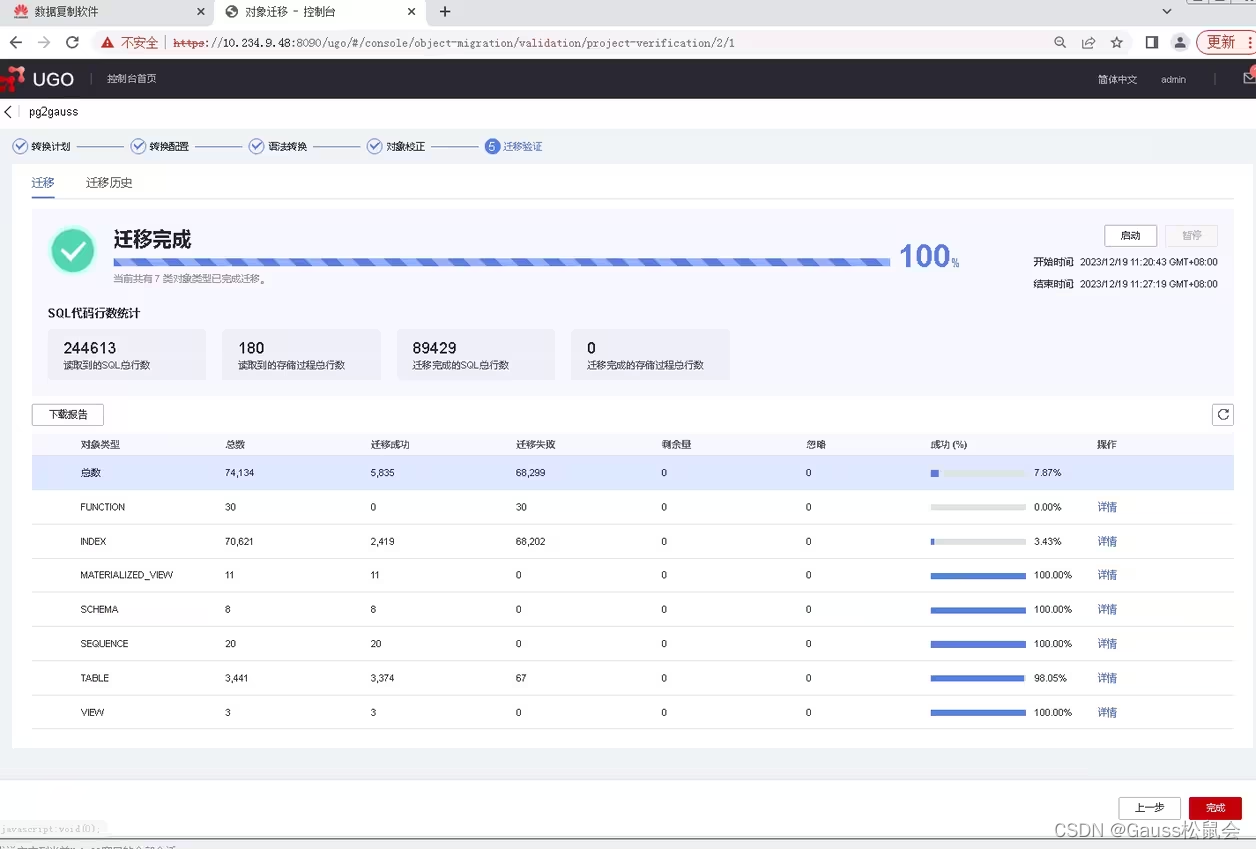
五、DRS迁移数据
5.1 创建复制用户
通过管理员账号登录
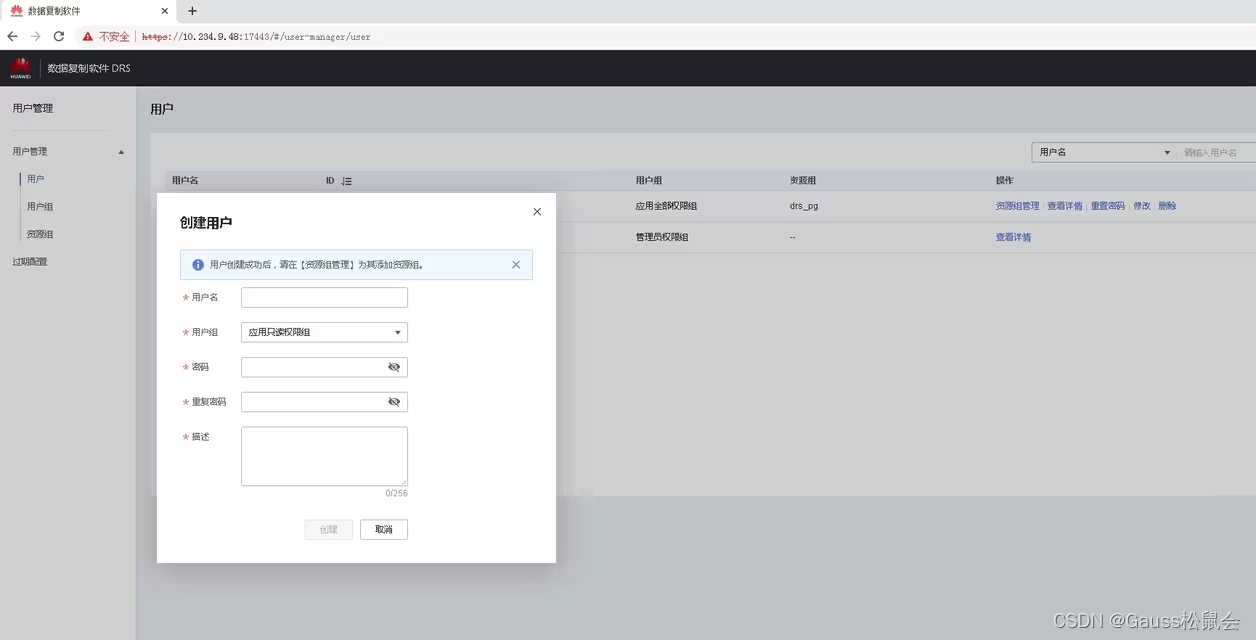
创建资源组

5.2创建迁移任务。
使用复制账号drs登录,创建同步任务

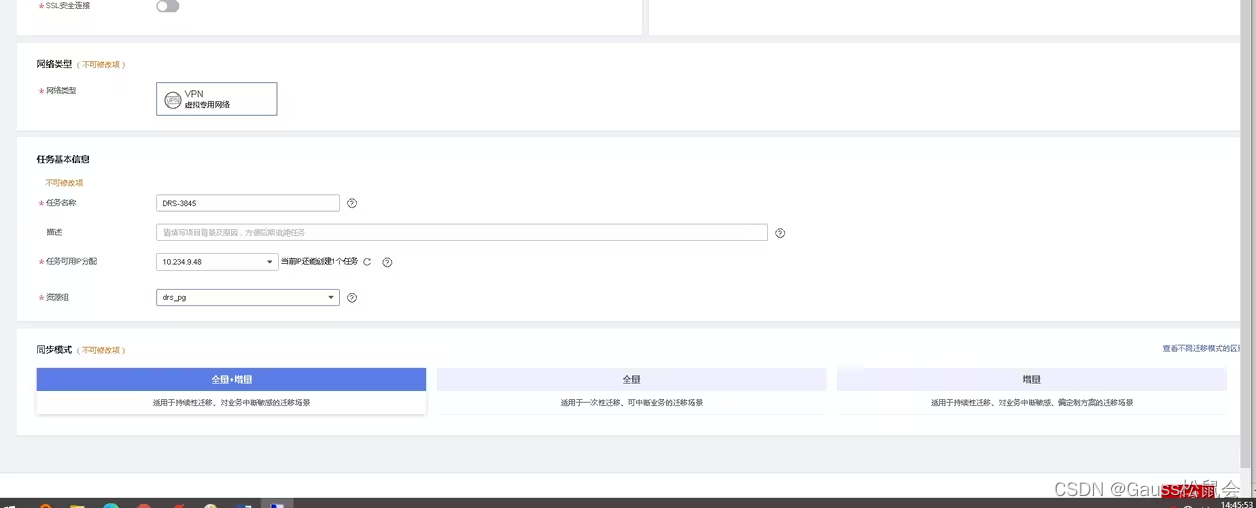
点击测试连接,成功后执行下一步
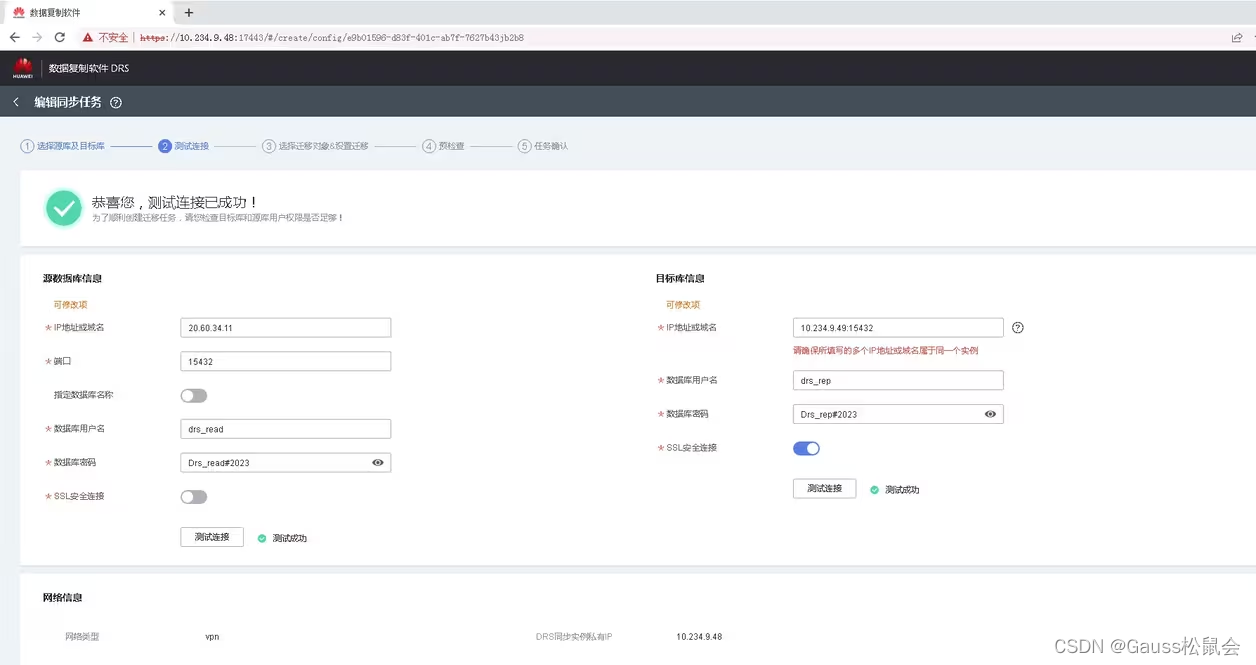
选择要迁移的对象
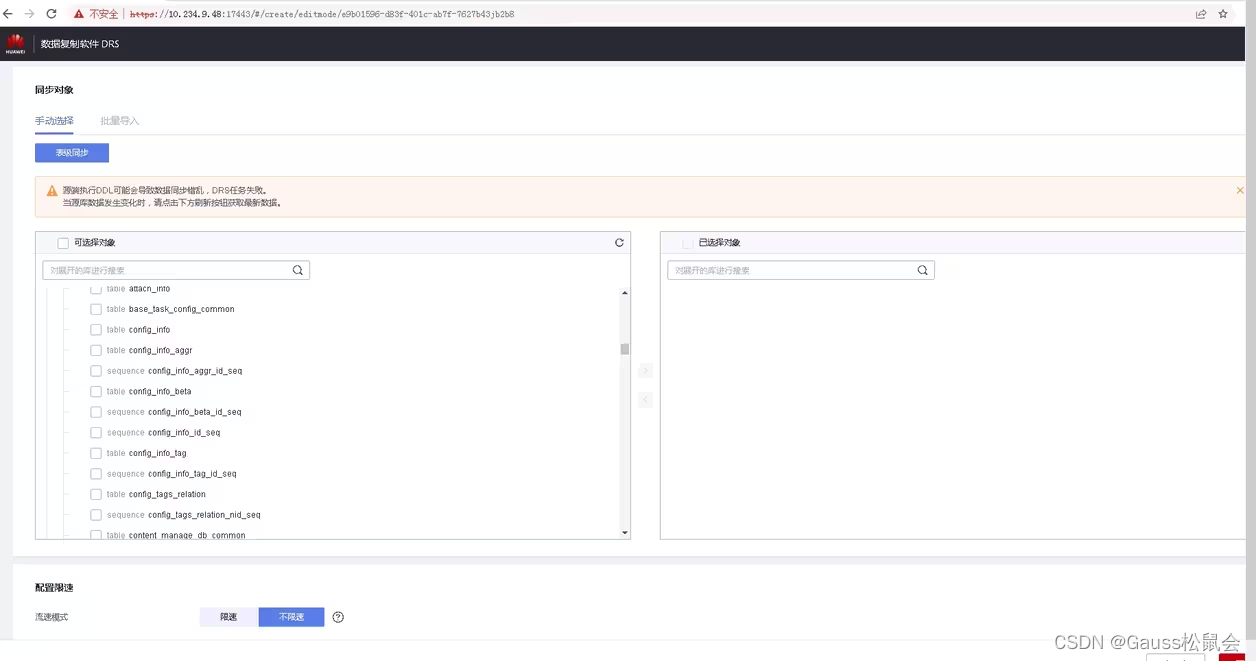
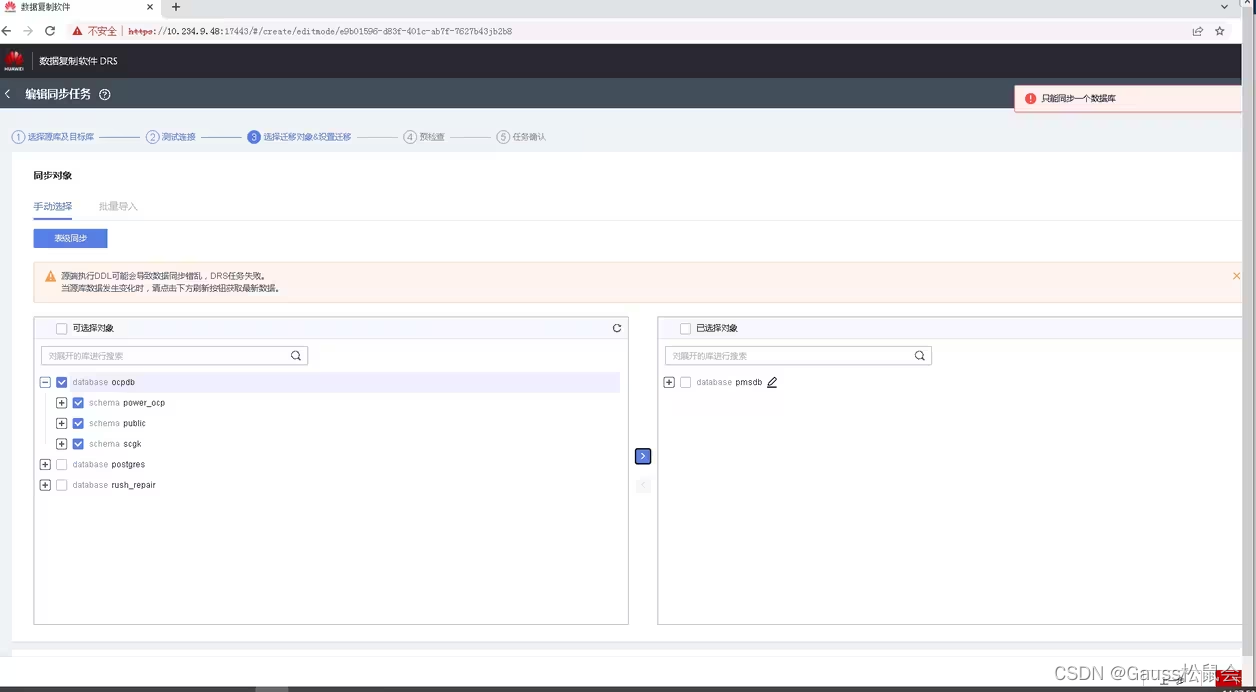
从列表中可以看出,工具仅支持表和序列的迁移,同时只能迁移一个库。下方限速可针对迁移带宽速率进行调整。

下一步进入迁移前的检查,如果权限不足会提示需要哪些权限,需完成整改后进入下一步
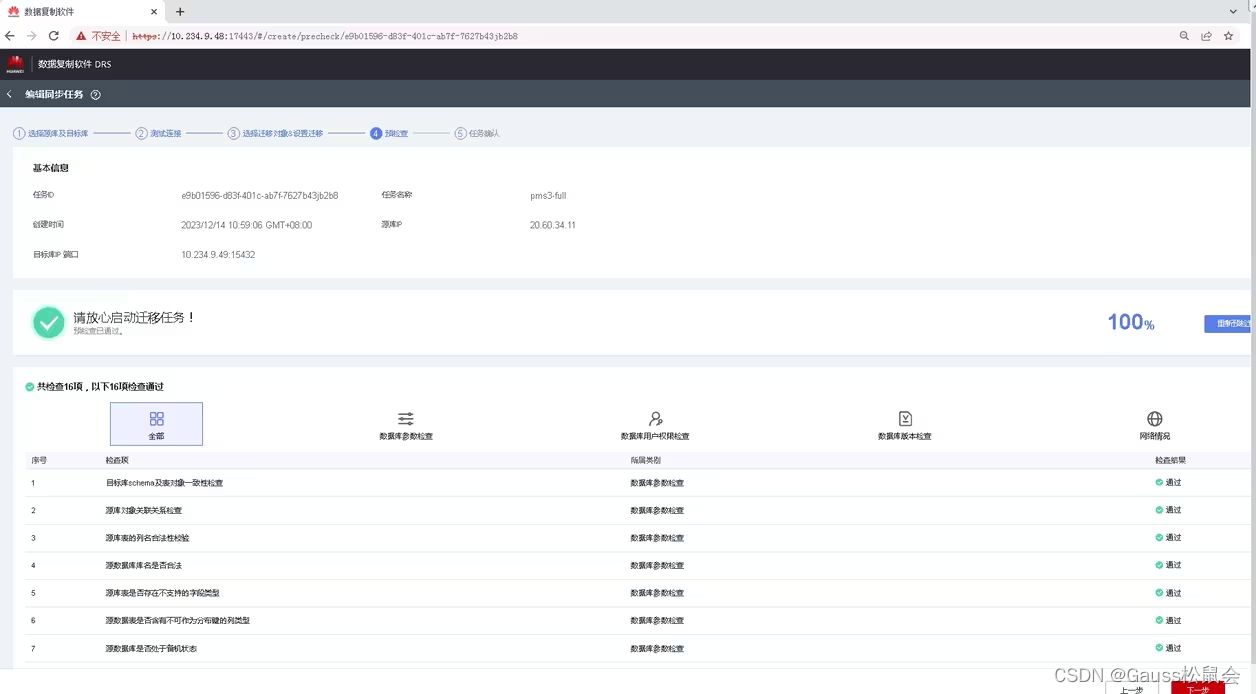

六、迁移后一致性检查
6.1使用DRS工具对比
在DRS任务管理中,可以看到数据迁移进度,在任务结束后可以进行数据对比,如图所示

也可以通过日志看到迁移结果,如图所示:
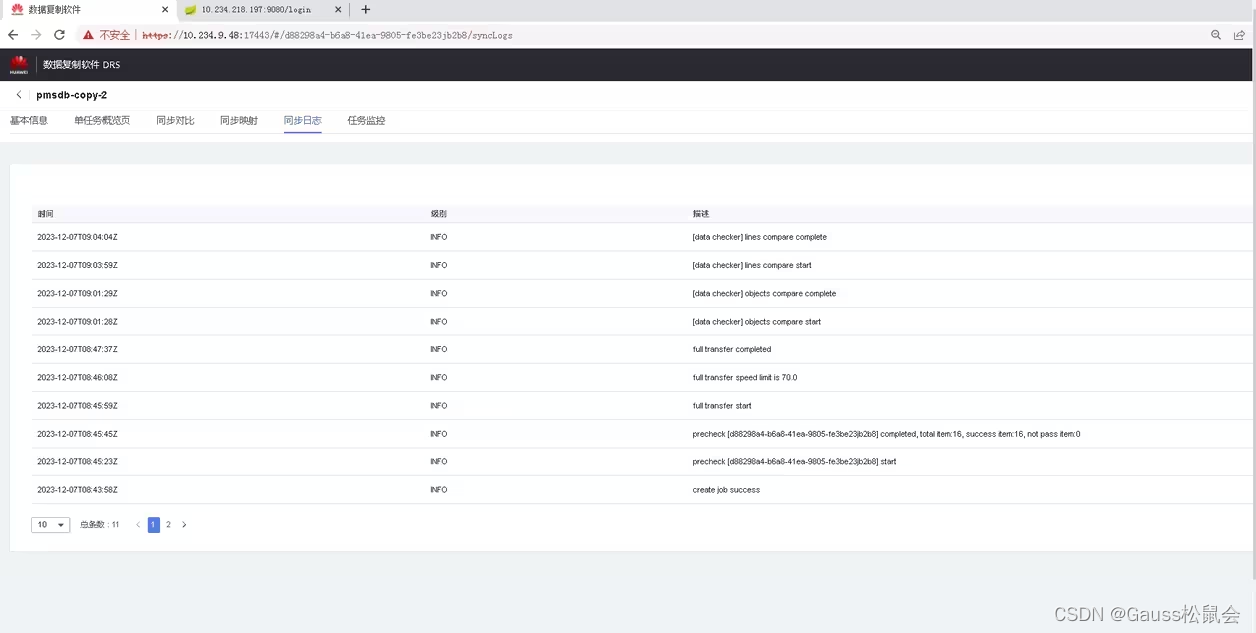
6.2手动对比
通过登录源库和目标库,分别使用脚本统计各个对象数量。
七、问题总结及解决方法
7.1 用户迁移
问题描述:DRS工具和UGO工具无法迁移用户,需在目标库创建用户以及授权。
处理方法:手动创建。
# su – omm
gsql –d postgres –p 15432 –r
create user drmc password 'PAssw0rd_2023';
授权连接测试
gsql -d postgres -p 15432 -U drmc -W PAssw0rd_2023 -r 7.2 序列迁移
问题描述:DRS工具或UGO工具迁移序列到目标库,序列会重新从初始值开始递增,如果业务切换至目标库会导致采用序列做为主键的列值冲突
解决方法:列举所有scheme的序列,收集当前序列值,在目标库重置当前值。
源库收集序列当前值
select * from pg_sequence;
收集每个序列last_value
目标库重置每个序列的当前值
Select setval(‘序列名称’,‘当前值’);
Gsql –p 15432 –d postgres -r
Gaussdb=#\d+ 序列名---查看当前值7.3 分区表迁移
问题描述:DRS工具在迁移分区表时会将分区表转化成普通表。UGO在PG迁移至GaussDB数据库中,由于语法不兼容问题,需要手动修改语法来实现。
解决方法:1、手动创建分区表,然后导入数据。
# su – opostgres
收集所有分区表
select nmsp_parent.nspname as
parent_schema,
parent.relname as parent,
nmsp_child.nspname as child_schema,
child.relname as child_name
from pg_inherits
join pg_class parent
on pg_inherits.inhparent=parent.oid
join pg_class child
on pg_inherits.inhrelid=child.oid
join pg_namespace nmsp_parent
on nmsp_parent.oid=parent.relnamespace
join pg_namespace nmsp_child
on nmsp_child.oid=child.relnamespace;
手动创建分区表
示例:CREATE TABLE power_sch.abc (
obj_id NVARCHAR2(42) NOT NULL,
sun_year_month NVARCHAR2(42)
CONSTRAINT " abc_pkey" PRIMARY KEY (sun_year_month, obj_id)
)
PARTITION BY LIST (sun_year_month);
添加分区:
alter table power_sch.abc add partition abc_201201 VALUES ('201201');7.4 函数迁移
问题描述:支持迁移普通自定义函数,依赖PG插件的函数需手动改写。
解决方法:1、手动改写实现相关功能。
select a.usename,b.proname from pg_user a,pg_proc b where a.usesysid=b.proowner and a.usename<>'postgres';7.5 外键改造
问题描述:在迁移中发现GaussDB分布式数据库不支持外键,需要将表的外键用触发器形式实现,在UGO迁移过程中提示:FOREIGN KEY …REFERENCES constraint is not yet supported.
解决方法1:使用GaussDB集中式支持外键约束。
解决方法2:GaussDB分布式数据库处理外键约束的方法。
场景1:一个父表,一个子表,trigger完全等价
1.创建两个表,一个主表和一个从表,主表中包含主键列,从表中包含外键列。
CREATE TABLE parent (
id INT PRIMARY KEY,
name VARCHAR(50) NOT NULL
);
CREATE TABLE child (
id INT,
parent_id INT,
name VARCHAR(50) NOT NULL,
FOREIGN KEY (parent_id) REFERENCES parent(id)
); 2.向主表中插入数据。
INSERT INTO parent (id, name) VALUES (1, 'John');
INSERT INTO parent (id, name) VALUES (2, 'Jane');
INSERT INTO parent (id, name) VALUES (3, 'Jane'); 3.向从表中插入数据,其中外键列的值应该与主表中的主键列的值相匹配。
INSERT INTO child (id, parent_id, name) VALUES (1, 1, 'Tom');
INSERT INTO child (id, parent_id, name) VALUES (2, 2, 'Jerry');4.尝试插入一条不匹配的从表数据,即外键列的值与主表中不存在的主键列的值相匹配。此时应该抛出异常。
INSERT INTO child (id, parent_id, name) VALUES (4, 4, 'Spike');
---结果:ORA-02291: 违反完整约束条件 (UGO.SYS_C0087731) - 未找到父项关键字5.update子表,无法成功
update child set parent_id=22 where id=2;
---结果:ORA-02291: 违反完整约束条件 (UGO.SYS_C0087731) - 未找到父项关键字1.2GaussDB替代方案:分布式不支持外键,使用trigger保证外键约束的一致性,如果依赖的父表存在,insert,不存在raise
1.创建两个表,一个主表和一个从表,主表中包含主键列,从表中包含外键列。
CREATE TABLE parent (
id INT PRIMARY KEY,
name VARCHAR(50) NOT NULL
);
CREATE TABLE child (
id INT PRIMARY KEY,
parent_id INT,
name VARCHAR(50) NOT NULL/*,
FOREIGN KEY (parent_id) REFERENCES parent(id)*/ --注释掉外键
);
使用trigger实现等价功能--外键一致性
--触发函数
create or replace function func_child() return trigger
as
id_values int;
BEGIN
SELECT COUNT(id) INTO id_values
FROM parent
WHERE id = NEW.parent_id;
IF id_values=0 THEN
RAISE EXCEPTION '%' , 'Foreign key constraint violated because the id column value does not exist in the parent table.';
else
RETURN NEW;
END IF;
end;
/
--触发器
DROP TRIGGER if exists tri_child on child;
CREATE TRIGGER tri_child
before insert or update on child
FOR EACH ROW
EXECUTE PROCEDURE func_child();2.向主表中插入数据。
INSERT INTO parent (id, name) VALUES (1, 'John');
INSERT INTO parent (id, name) VALUES (2, 'Jane');
INSERT INTO parent (id, name) VALUES (3, 'Jane'); 3.向从表中插入数据,其中外键列的值应该与主表中的主键列的值相匹配。
INSERT INTO child (id, parent_id, name) VALUES (1, 1, 'Tom');
INSERT INTO child (id, parent_id, name) VALUES (2, 2, 'Jerry'); 4.尝试插入一条不匹配的从表数据,即外键列的值与主表中不存在的主键列的值相匹配。此时应该抛出异常。
INSERT INTO child (id, parent_id, name) VALUES (4, 4, 'Spike');
ugo=> INSERT INTO child (id, parent_id, name) VALUES (4, 4, 'Spike');
ERROR: Foreign key constraint violated because the id column value does not exist in the parent table. 5.update子表,无法成功
update child set parent_id=22 where id=2;
ugo=> update child set parent_id=22 where id=2;
ERROR: Foreign key constraint violated because the id column value does not exist in the parent table. 场景2:多个父表,一个子表,trigger完全等价
2.1多外键:
1.创建两个表,两个主表和一个从表,主表中包含主键列,从表中包含外键列。
drop table parent;
CREATE TABLE parent (
id INT PRIMARY KEY,
name VARCHAR(50) NOT NULL
);
drop table parent1;
CREATE TABLE parent1 (
id INT ,
idname VARCHAR(50) PRIMARY KEY
);
drop table child;
CREATE TABLE child (
id INT ,
parent_id INT,
name VARCHAR(50) NOT NULL,
FOREIGN KEY (parent_id) REFERENCES parent(id),
FOREIGN KEY (name) REFERENCES parent1(idname)
);2.向主表中插入数据。
INSERT INTO parent (id, name) VALUES (1, 'John');
INSERT INTO parent (id, name) VALUES (2, 'Jane');
INSERT INTO parent (id, name) VALUES (3, 'Jane');
INSERT INTO parent1 (id, idname) VALUES (1, 'John1');
INSERT INTO parent1 (id, idname) VALUES (2, 'Jane1');
INSERT INTO parent1 (id, idname) VALUES (3, 'xxJane1');3.向从表中插入数据,其中外键列的值应该与主表中的主键列的值相匹配。
INSERT INTO child (id, parent_id, name) VALUES (1, 1, 'John1');
INSERT INTO child (id, parent_id, name) VALUES (2, 2, 'xxJane1'); 4.尝试插入一条不匹配的从表数据,即外键列的值与主表中不存在的主键列的值相匹配。此时应该抛出异常。
INSERT INTO child (id, parent_id, name) VALUES (1, 1, 'Tom');
INSERT INTO child (id, parent_id, name) VALUES (1, 4, 'John1');
INSERT INTO child (id, parent_id, name) VALUES (4, 4, 'Spike');
---结果:ORA-02291: 违反完整约束条件 (UGO.SYS_C0087731) - 未找到父项关键字5.update子表,无法成功
update child set parent_id=22 where id=2;
---结果:ORA-02291: 违反完整约束条件 (UGO.SYS_C0087731) - 未找到父项关键字 2.2GaussDB替代方案:分布式,使用trigger完全等价
1.创建两个表,两个主表和一个从表,主表中包含主键列,从表中包含外键列。
drop table parent;
CREATE TABLE parent (
id INT PRIMARY KEY,
name VARCHAR(50) NOT NULL
);
drop table parent1;
CREATE TABLE parent1 (
id INT ,
idname VARCHAR(50) PRIMARY KEY
);
drop table child;
CREATE TABLE child (
id INT ,
parent_id INT,
name VARCHAR(50) NOT NULL/*,
FOREIGN KEY (parent_id) REFERENCES parent(id),
FOREIGN KEY (name) REFERENCES parent1(idname)*/
);
trigger实现等价功能
--触发函数
create or replace function func_child() return trigger
as
parent_id_values int;
name_values int;
BEGIN
SELECT COUNT(id) INTO parent_id_values
FROM parent
WHERE id = NEW.parent_id;
SELECT COUNT(idname) INTO name_values
FROM parent1
WHERE idname = NEW.name;
IF parent_id_values=0 or name_values=0 THEN
RAISE EXCEPTION '%', 'Foreign key constraint violated because the id column value and idname column value does not exist in the parent table and parent1 table .';
else
RETURN NEW;
end if;
end;
/
--触发器
DROP TRIGGER if exists tri_child on child;
CREATE TRIGGER tri_child
before insert or update on child
FOR EACH ROW
EXECUTE PROCEDURE func_child(); 2.向主表中插入数据。
INSERT INTO parent (id, name) VALUES (1, 'John');
INSERT INTO parent (id, name) VALUES (2, 'Jane');
INSERT INTO parent (id, name) VALUES (3, 'Jane');
INSERT INTO parent1 (id, idname) VALUES (1, 'John1');
INSERT INTO parent1 (id, idname) VALUES (2, 'Jane1');
INSERT INTO parent1 (id, idname) VALUES (3, 'xxJane1'); 3.向从表中插入数据,其中外键列的值应该与主表中的主键列的值相匹配。
INSERT INTO child (id, parent_id, name) VALUES (1, 1, 'John1');
INSERT INTO child (id, parent_id, name) VALUES (2, 2, 'xxJane1');4.尝试插入一条不匹配的从表数据,即外键列的值与主表中不存在的主键列的值相匹配。此时应该抛出异常。
INSERT INTO child (id, parent_id, name) VALUES (1, 1, 'Tom');
INSERT INTO child (id, parent_id, name) VALUES (1, 4, 'John1');
INSERT INTO child (id, parent_id, name) VALUES (4, 4, 'Spike');
ugo=> INSERT INTO child (id, parent_id, name) VALUES (1, 1, 'Tom');
ERROR: Foreign key constraint violated because the id column value and idname column value does not exist in the parent table and parent1 table .
ugo=> INSERT INTO child (id, parent_id, name) VALUES (1, 4, 'John1');
ERROR: Foreign key constraint violated because the id column value and idname column value does not exist in the parent table and parent1 table .
ugo=> INSERT INTO child (id, parent_id, name) VALUES (4, 4, 'Spike');
ERROR: Foreign key constraint violated because the id column value and idname column value does not exist in the parent table and parent1 table . 5.update子表,不成功
update child set parent_id=22 where id=1;
update child set name='xiaowang' where parent_id=2;
ERROR: Foreign key constraint violated because the id column value and idname column value does not exist in the parent table and parent1 table .7.6 索引改造
问题描述1:目标库采用GaussDB分布式数据库时,在使用UGO工具迁移索引过程中,提示Cannot create index whose evaluation cannot be enforced to remote nodes.
问题描述2:在使用UGO工具迁移索引过程中,分区表索引无法迁移,需要手动获取源端索引定义手动创建。
处理方法1:到数据库中查找表对象的分布键,添加分布列id到索引个。
示例:power_ocp.config_info_bak对象,可以在数据库中使用
\d+ power_ocp.config_info_bak来查找该对象的分布键,即下图红线中显示的Distribute By后的关键字
处理方法2:手动获取源端分区表索引定义
Select * from pg_indexes where tablename in (‘’,’’); 手动执行索引定义
PG数据库迁移至GaussDB测试分享到此结束,欢迎大家一起交流学习~









